#BILD Germany
Explore tagged Tumblr posts
Text
Thats Germany!
Why the hell are you immediately an anti-Semite if you criticize Israel?
In Germany, pro-Palestine demonstrations are unwelcome. In the German Basic Law its written about freedom of speech, freedom of religion, freedom of assembly. At present exactly these laws are ignored and pro Palestine demonstration are stamped as a meetingplace of the radical Muslims.
The press BILD is currently trying to publish many reports that are clearly directed against Muslims.
If I want to go to a pro Palestine demonstration, I don't need a special religion or nationality. I go to the demonstration because I am against this genocide and not because I am a radical Muslim or anti-Semitie.
Today's German people are not guilty for the past history of Germany and Israel. If we want to demonstrate against a genocide, Germany is the last country to forbid it. Because no innocent Palestinian is guilty for the history of Germany.
And if we are against war, then we have the right to speak and no government can take that away from us.
And we are supposed to live in a democracy?xD
Please wake up
#free palestine#palestine#free gaza#gaza#israel is committing genocide#isreal#stop the genocide#genocide#fuckbild#BILD#BILD Germany#germany#freedom#we are not numbers#ethnic cleansing#islam is peace#freedom of speech#freedom of assembly#freedom of religion#BILD Magazin#Israel#fuck israel#israel is a terrorist state#israel is an apartheid state#gaza strip#gaza under attack#israël#gaza genocide#save gaza#gazaunderattack
17 notes
·
View notes
Text
if schalke really make fernando torres their new manager, i will absolutely be going to gelsenkirchen to see that beautiful man in the flesh
#but then again#apparently die bild is the source so#it's like the german sun#in germany we say 'glaub ich erst wenn ich's sehe' and i think that's beautiful#fernando torres#football
16 notes
·
View notes
Text
Germany delays selling weapons to Israel but continues sales to Qatar, sparking criticism
Story by BENJAMIN WEINTHAL
Germany’s federal government continues to ignore Israeli requests to purchase weapons, according to a Sunday report in the mass circulation daily Bild.
According to Bild, “Last year, the Israeli government had already requested the purchase of several thousand pieces of ammunition for its main battle tanks, and there were further requests for other types of armament.”
The Bild journalist Björn Stritzel, who authored the report and has solid contacts with security sources in Germany, wrote, “For the Jewish state, which is currently fighting on several fronts against the terrorist groups Hamas and Hezbollah, the purchase of certain military equipment from abroad is particularly important.”

Prime Minister Benjamin Netanyahu and German Chancellor Olaf Scholz in Israel on March 17, 2024 (credit: KOBI GIDEON/GPO)
According to BILD information, Qatar will receive ”The modern RCH 155 wheeled howitzers. The system is based on the self-propelled howitzer 2000... The main advantage of the system: It can fire precisely while moving.”
The head of the American Jewish Committee office in Berlin, Remko Leemhuis, told Bild about Germany selling weapons to Qatar instead of Israel that “It should also be remembered once again how these people celebrated the antisemitic mass murder on October 7 in Qatar.”
13 notes
·
View notes
Text
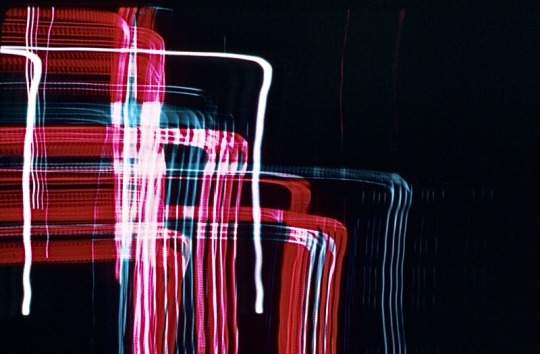
László Moholy-Nagy (Hungarian, 1895-1946)
Untitled, 1939
Fujicolor Crystal Archive print, 27.9 x 35.6cm
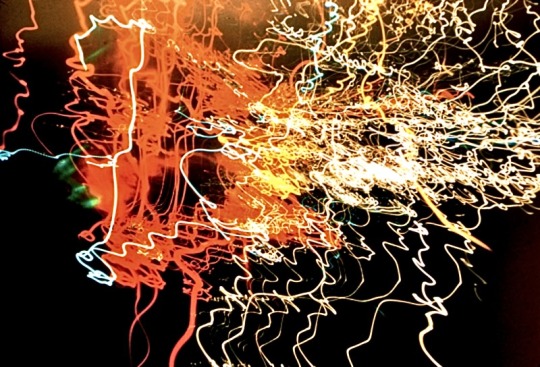
László Moholy-Nagy (Hungarian, 1895-1946)
Untitled, 1937-1946
Fujicolor Crystal Archive print, 27.9 x 35.6cm
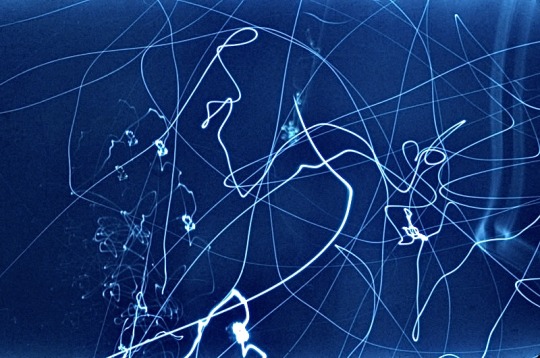
László Moholy-Nagy (Hungarian, 1895-1946)
Untitled, 1936-46
Fujicolor Crystal Archive print, 27.9 x 35.6 cm
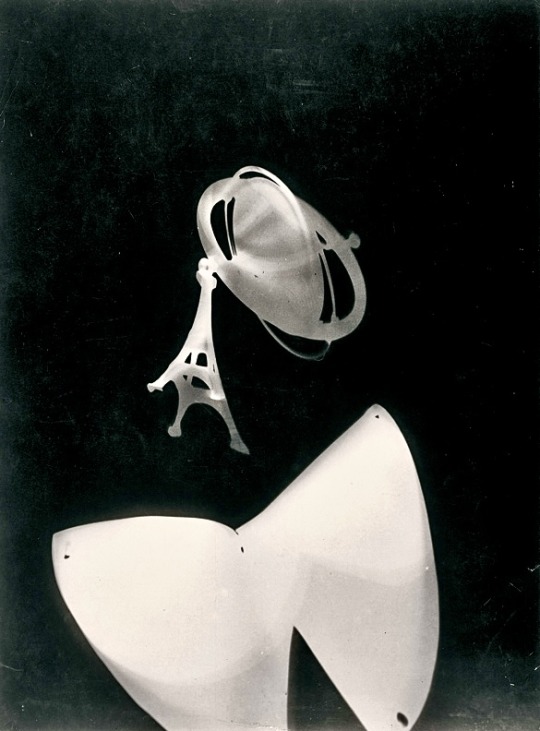
László Moholy-Nagy (Hungarian, 1895-1946)
Photogram with Eiffel Tower and Peg Top, 1928
Silver gelatin photograph, 38.7 x 29.9cm
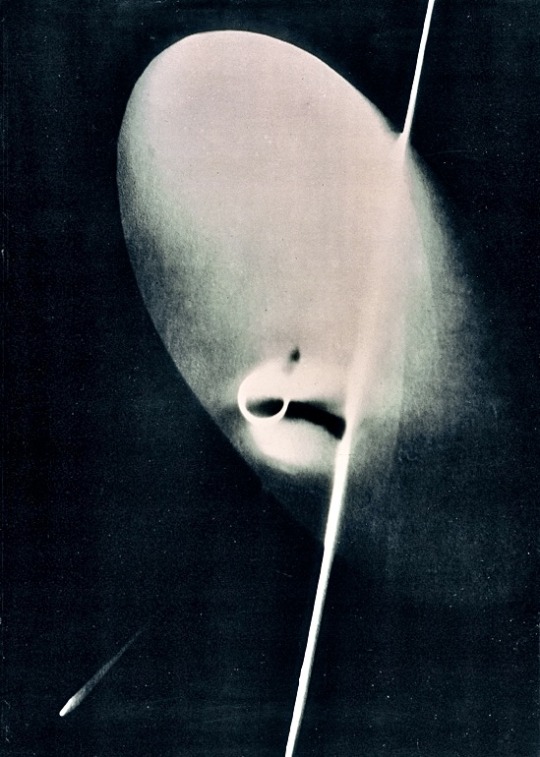
László Moholy-Nagy (Hungarian, 1895-1946)
Photogram No. II, 1929
Silver gelatin photograph, 95.5 x 68.5cm
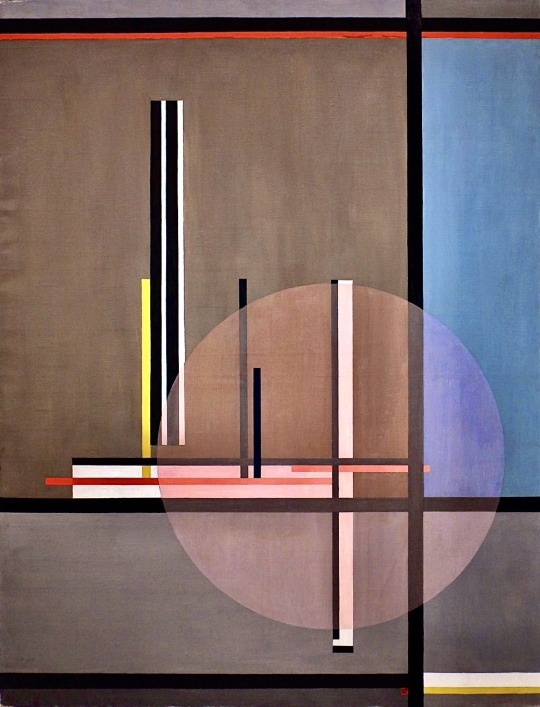
László Moholy-Nagy (Hungarian, 1895-1946)
LIS, 1922
Oil on canvas, 131 x 100cm

László Moholy-Nagy (Hungarian, 1895-1946)
K XVII, 1923
Oil on canvas, 95 x 75cm
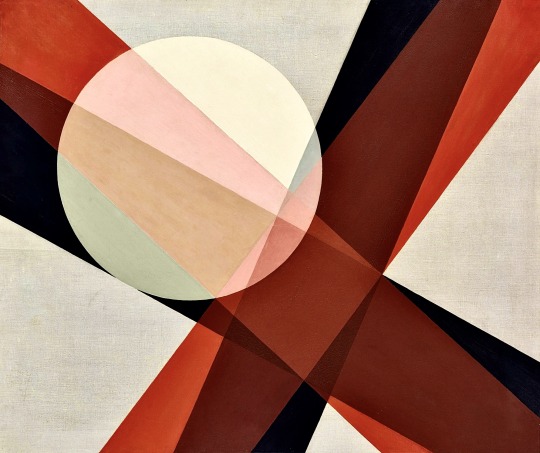
László Moholy-Nagy (Hungarian, 1895-1946)
A 19, 1927
Oil on canvas, 80 x 96cm
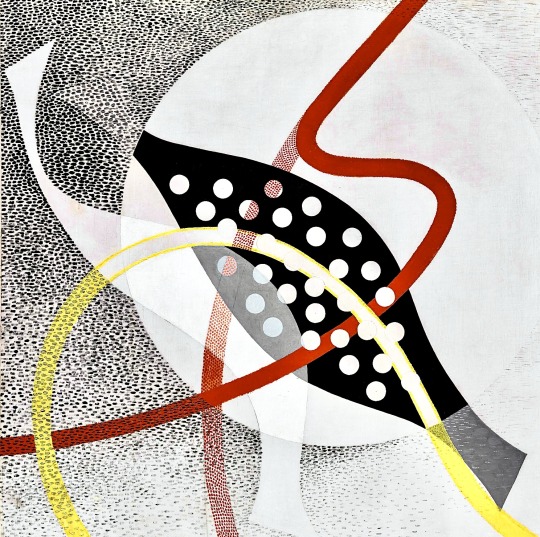
László Moholy-Nagy (Hungarian, 1895-1946)
CH BEATA I, 1939
Oil on canvas, 119 x 120cm
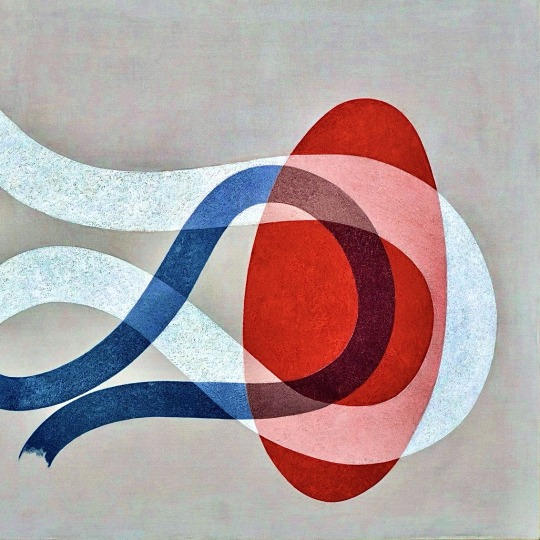
László Moholy-Nagy (Hungarian, 1895-1946)
CH SPACE 6, 1941
Oil on canvas, 119 x 119cm
László Moholy-Nagy Retrospective exhibition at Schirn Kunsthalle, Frankfurt
8th October 2009 - 7th February 2010
Artworks © Hattula Moholy-Nagy for the Estate of László Moholy-Nagy © VG Bild-Kunst, Bonn 2009 / Artists Rights Society (ARS), New York
ART BLART_ ART AND CULTURAL MEMORY ARCHIVE
Curated blog and article by Dr. Marcus Bunyan:
•
•
▪️YouTube silent video >> László Moholy-Nagy Ein Lichtspiel Schwarz Weiss Grau (Light Play: Black, White, Grey) [1930 / 6mins.+34secs.]:
youtube
Ein Lichtspiel Schwarz Weiss Grau (Light Play Black White Grey) is perhaps Lázló Moholy-Nagy's best-known film work. It features his Light-Space Modulator, also known as a lighting fixture for an electric stage.
Light-Space Modulator is a key work in the history of kinetic art and even new media art, and therefore one of the most important works of art of its time.
Initially conceived by Moholy-Nagy in the early 1920s and built between 1928 and 1930, its completion required the involvement of a number of collaborators.
It was intended to be the centrepiece of the Contemporary Room at the Provinzialmuseum in Hanover, planned (but never realised) by Moholy-Nagy and Alexander Corner, the museum's director.
Light-Space Modulator was exhibited in 1930 at an exhibition in Paris on the work of the German Werkbund. From the point of view of the object, it forms a complex and beautiful set of metal, plastic and glass elements, many of them movable by the action of an electric motor, surrounded by a series of coloured lights.
Moholy-Nagy used it to produce light shows that he then photographed or filmed, as in the case of the film shown here. Although in black and white, the film manages to capture the kinetic glow of the sculpture.
•
•
▪️YouTube video >> László Moholy-Nagy: Proto-Conceptual Artist [2019 / 5mins.+36secs.]:
youtube
Coinciding with the Bauhaus centenary, Hattula Moholy-Nagy and Daniel Hug, the daughter and grandson of László Moholy-Nagy, consider the lasting impact of the artist’s work today. Hauser & Wirth’s exhibition in London dedicated to Moholy-Nagy examines his influence as a proto-conceptualist, whose work interrogated the role of the art object and the artist in society, anticipating questions posed by subsequent generations of artists.
László Moholy-Nagy is on view at Hauser & Wirth London from 22 May – 7 September 2019.
•
•
▪️ YouTube video >> Moholy-Nagy: Future Present exhibition overview at the Guggenheim [2016 / 3mins+14secs.]:
youtube
Curator Karol P. B. Vail provides a brief introduction to Moholy-Nagy: Future Present, a comprehensive retrospective of the work of László Moholy-Nagy (1895–1946), on view at the Solomon R. Guggenheim Museum, New York, May 27–September 7, 2016. To learn more visit https://www.guggenheim.org/moholy.
•
#Art & artists#Artworks by Lázló Moholy-Nagy#Paintings#Drawings#Photography#Photograms#Sculpture#Light sculptures#Cinema#Films#Stage set design#Typographical projects#Kinetic art#Experimental art#New media art#Modernism#Abstraction#Conceptual art#Bauhaus - Germany#New Bauhaus - Chicago#Schirn Kunsthalle - Frankfurt#Guggenheim Museums#Hauser & Wirth - London#Hattula Moholy-Nagy#Estate of László Moholy-Nagy#VG Bild-Kunst Bonn#Artists Rights Society (ARS) New York#Dr. Marcus Bunyan#Art Blart#YouTube
20 notes
·
View notes
Text



















Impressionen von einem Trödelmarkt.
#Trödelmarkt#old#helm#helmet#niederlausitz#lower lusatia#east germany#gestein#waage#koffer#technik#history#pova start#bild#colors#fotos#kamera#buch#books#zeitungen#old picture
4 notes
·
View notes
Text




🇩🇪 🚨
TWO THIRDS OF GERMANS WANT A CHANGE IN LEADERSHIP
German Prime Minister Olaf Scholz, 65y, of the German Social-Democrafic Party (SPD), is now the most unpopular Prime Minister in German history, according to polls conducted by the INSA research institute [Institut für neue soziale Antworten].
Nearly 2/3rd's of German's, (64.3%) prefer German Defense Minister, Boris Pistorius, 63y, also of SPD, over Prime Minister Scholz. While only 24.6% oppose the change in leadership.
Even among SPD voters, a slim majority support a change in leadership by a narrow margin of 47.9% for Pistorius and 47.1% for Scholz.
In a competition with an unknown opposition candidate, only 19% of German voters say they would vote for SPD with Scholz as its leader, while 23% say the same with Pistorius at the helm of SPD.
In a direct contest with Christian Democratic Union (CDU) leader, Frederick Merz, 68y, the CDU leader leads over Scholz and SPD by a margin of 26% to 23%.
#source
@WorkerSolidarityNews
#germany#germany news#german news#bild#insa#europe#europe news#european news#central europe#german politics#european politics#global politics#world politics#politics#news#geopolitics#world news#global news#international news#breaking news#current events
5 notes
·
View notes
Text

Alle Reden
Alle reden vom Stand der Wissenschaft. Wir von ihrem Wetter.
#vergleichende Meteorologie#marxistische variationen#archiv der revolte#das bild hing schief#the loriotization of germany
3 notes
·
View notes
Photo

Eyewitness Accounts of the Holocaust
The Holocaust was the murder of 6 million Jewish people by the SS, Gestapo, and other organisations of Nazi Germany and its allies in the years prior to and through the Second World War (1939-45). Innocent men, women, and children were shot in mass executions, or, if not too young or too old, they were sent to labour camps where they worked until they could do so no longer. The ultimate fate of millions was to die in the gas chambers of extermination camps like Auschwitz in occupied Poland.
In this article, accounts are presented by those who witnessed the Holocaust genocide firsthand, both its victims and those involved in its execution who were obliged to give evidence in, for example, the post-war Nuremberg trials of 1945-6.
Unburied Corpses, Bergen-Belsen Concentration Camp
Wislon-Oakes - Imperial War Museums (CC BY-NC-SA)
The Nazis & the Jews
Adolf Hitler (1889-1945) established himself as the dictator of Nazi Germany in 1933, and he identified Jewish people as the main enemy of the state. Based on dubious and inconsistent racial theory as propounded by such Nazi figures as Alfred Rosenberg (1893-1946), Hitler and the Nazi Party began a propaganda campaign against German Jews, which presented them as an inferior race who were holding Germany back from achieving its full economic potential.
Hitler wanted to remove all Jews from German territory, but the first step was to identify who exactly was a Jew. The 1935 Nuremberg Laws loosely identified Jews since even having a single Jewish grandparent placed an individual in that category. A series of 'solutions' to what Hitler called the "Jewish problem" were rolled out, such as encouraging emigration and persecuting Jewish business owners. Jews were then attacked in such pogroms as the Kristallnacht of November 1938. Next, Jews were rounded up and obliged to live in segregated areas such as ghettos in cities or in concentration camps. Jews were deprived of citizenship and other basic rights.
From 1942, the Nazis began what was secretly described as the 'Final Solution', that is the plan to murder all European Jews. Jews were transported to labour camps where they worked on state projects until they died from disease, extreme malnutrition, or physical exhaustion. Other Jews, and those who could no longer work or were too young or too old to work, were transported directly to death camps like the Auschwitz-Birkenau complex in occupied Poland where they were killed in gas chambers and their remains were communally cremated. Jews were not the only victims since the Nazis also targeted Romani people, Communists, Jehovah's Witnesses, Freemasons, homosexuals, political rivals, prisoners of war, and those with physical or mental disabilities, amongst others. In addition, hundreds of thousands more victims were murdered in mass executions in occupied territories during the Second World War by mobile killing squads known as Einsatzgruppen. The Jews made up by far the majority of those killed, and it is estimated that 6 million died in what is today called the Holocaust. The sheer scale of the Nazis' programme means that determining the precise number of victims is not possible.
Arrested Jews, Baden-Baden
Bundesarchiv, Bild 183-86686-0008 (CC BY-SA)
Hugh Greene, a British newspaper journalist, recalls what he saw of the Kristallnacht in 1938:
I was in Berlin at that time and saw some pretty revolting sights – the destruction of Jewish shops, Jews being arrested and led away, the police standing by while the gangs destroyed the shops and even groups of well-dressed women cheering.
(Holmes, 42)
Avraham Aviel, a Polish Jew and survivor of a mass execution, gives the following account of his experience in May 1942:
We were all brought close to the cemetery at a distance of eighty to a hundred metres from a long, deep pit. Once again everybody was made to kneel. There was no possibility of lifting one's head. I sat more or less in the centre of the town people. I looked in front of me and saw the long pit then maybe groups of twenty, thirty people led to the edge of the pit, undressed probably so that they should not take their valuables with them. They were brought to the edge of the pit where they were shot and fell into the pit, one on top of another.
(Holmes, 319)
An anonymous survivor from a ghetto massacre in Lviv, Ukraine, in August 1942 gives the following description of its aftermath:
I went with my mother to the office of the Jewish community regarding an apartment and there in the light breeze, dangled the corpses of the hanged, their faces blue, their heads tilted backward, their tongues blackened and stretched out. Luxury cars raced in from the center of the city, German civilians with their wives and children came to see the sensational spectacle, and, as was their custom, the visitors enthusiastically photographed the scene. Afterwards the Ukrainians and Poles arrived by with greater modesty.
(Fiedländer, 436)
Nazi Classification of Jewish People
VolksVeritas (CC BY-SA)
Rivka Yoselevska, a Polish Jew, describes her experience and that of her family in the Hansovic ghetto massacre in August 1943:
Some of the younger ones I got out naked covered with blood…I was still alive. Where should I go? What should I do?
(Holmes, 320-1)
The SS lieutenant-colonel Adolf Eichmann (1906-1962), in charge of the Final Solution's transportation requirements, here lies to Jews to make sure they do not create trouble as they are transported by train from a ghetto to the concentration camps:
Jews: You have nothing to worry about. We want only the best for you. You'll leave here shortly and be sent to very fine places indeed. You will work there, your wives will stay at home, and your children will go to school. You will have wonderful lives.
(Bascomb, 6)
The death camps were deliberately located in remote Poland to provide the Final Solution project more secrecy. Rudolf Höss (1901-1947), a camp commandant at Auschwitz, stated:
We were required to carry out these exterminations in secrecy, but of course the foul and nauseating stench from the continuous burning of bodies permeated the entire area and all of the people living in the surrounding communities knew that exterminations were going on at Auschwitz.
(Neville, 49)
New Arrivals at Auschwitz
Bernard Walter (Public Domain)
The typical conditions of the train journeys to the camps are described here by Avraham Kochav, an Auschwitz survivor:
There were twenty to twenty-five cars in every train…I heard terrible cries. I saw how people attack other people so as to have a place to stand, how people push each other so that they could stand somewhere or so that they could have air for breathing. It was terribly, terribly stifling. The first to faint were the children, women, old men, they all fell down like flies.
(Holmes, 332)
Zygmunt Klukowski, a Polish hospital director, describes the train journeys for Jewish people sent to the Belzec extermination camp in occupied Poland:
On the way to Belzec the Jews experience many terrible things. They are aware of what will happen to them. Some try to fight back. At the railroad station in Szczebrzeszyn a young woman gave away a gold ring in exchange for a glass of water for her dying child. In Lublin people witnessed small children being thrown through windows of speeding trains. Many people are shot before reaching Belzec.
(Friedländer, 358)
Yaacov Silberstein, a Jewish teenager, describes his arrival at Auschwitz in October 1942:
When we arrived we saw how the Jews were running to the electrified fence. There they stuck. They were tired of life; they could not continue in this fashion.
(Holmes, 330)
Dr Lucie Adelsberger, a prisoner of Auschwitz, describes the processing of new arrivals destined for the labour camps:
We undressed, had our hair cut – no actually our heads were shaved to stubble; then came the showers and finally the tattoos. This was where they confiscated the very last vestiges of our belongings; nothing remained…no written document that could have identified us, no picture, no written message from a loved one. Our past was cut off, erased…
(Cesarini, 656)
Aerial View of Auschwitz
South African Air Force (Public Domain)
Bernd Naumann, a survivor from the Birkenau camp, describes the prevalence of rats in the camp:
They gnawed not only at corpses but also at the seriously sick. I have pictures showing women near death being bitten by rats.
(Neville, 50)
Seweryna Smaglewska, a prisoner in the Birkenau women's camp, describes the living conditions there:
There were no roads, no paths between the blocks. In the depths of these dark dens, in bunks like multi-storied cages, the feeble light of a candle burning here or there flickered over naked, emaciated figures curled up, blue from the cold, bent over a pile of filthy rags, holding their shaved heads in their hands, picking out an insect with their scraggly fingers and smashing it on the edge of the bunk – that is what the barracks looked like in 1942.
(Cesarini, 528)
The SS, which managed the camps, made sure there was a hierarchy amongst the prisoners such as trustees who survived a little longer than the rest by being 'favoured' with certain duties such as burning the bodies in the crematoriums or beating other prisoners. SS Lance Corporal Richard Bock, a guard at Auschwitz-Birkenau, recalls:
A block chief would call out the kapo very fiercely, 'Kapo, come here.' The kapo came over and – boom – he hit the kapo in the face so hard that he fell over…And then he said, 'Kapo, can't you beat them any better than that?' And the kapo ran off and grabbed a club to beat up the prisoner squad quite indiscriminately. 'Kapo, come over here,' he shouted again. The kapo came and he said, 'Finish them off,' and then he went off again and he finished the prisoners off, he beat them to death…a kapo had to beat and club to save his own life.
(Holmes, 325)
Luggage of Auschwitz Victims
Jorge Láscar (CC BY)
Those meant for the gas chambers were often unaware of their fate. Bock describes the procedure that he witnessed with a colleague called Holbinger who was responsible for the Zyklon B tins that would produce the lethal gas:
…the new arrivals had to get undressed, and then the order came, 'Prepare for disinfection'. There were enormous piles of clothing…Lots of them hid their children under the clothes and covered them up and then they shouted, 'Get ready' and they all went out, they had to run naked approximately twenty yards from the hall across to Bunker One. There were two doors standing open and they went in there and when a certain number had gone inside they shut the doors. That happened about three times, and every time Holbinger had to go out to his ambulance and they took out a sort of tin – he and one of his block chiefs – and then he climbed up the ladder and at the top there was a round hole and he opened the little round door and held the tin there and shook it and then he shut the little door again. Then a fearful screaming started up and approximately after about ten minutes it slowly went quiet…They opened the door…then a blue haze came out. I looked in and I saw a pyramid. They had all climbed up on top of each other…They were all tangled, they had to tug and pull very hard to disentangle all these people.
(Holmes, 334-5)
Dov Paisikowic, a Russian-Jewish survivor of Auschwitz, was part of the team responsible for taking bodies out of the chambers, removing valuables such as rings and gold teeth, and then taking the corpses to the crematoria. He recalls:
…the doors were suddenly opened to the gas chambers. People, naked people, started falling out. We were all frightened, no one dared ask what it all was. We were immediately taken to the other side of this house and there we saw hell on this earth – large piles of dead people, and people dragging these dead to a long pit, about thirty metres in length and ten metres in width. There was a huge fire there, with tree trunks. On the other side fat was being taken out of this pit with a bucket.
(Holmes, 335)
Thousands of detainees in the camps were subjected to unnecessary and often horrific medical operations and experiments. One of the most infamous SS doctors was Josef Mengele (1911-1979), who performed all kinds of macabre operations at Auschwitz. Mengele was, though, only one part of a large SS medical team, which operated in many different camps. Dr Franz Blaha, a Czech detainee at the Dachau concentration camp, was obliged to work in this area of Nazi terror, specifically performing autopsies. Blaha reported:
From the middle of 1941 to the end of 1942 some 500 operations on healthy prisoners were performed. These were for the instructions of the SS medical students and doctors and included operations on the stomach, gall bladder and throat. These were performed by students and doctors of only two years' training, although they were very dangerous and difficult….Many prisoners died on the operating table and many others from later complications…These persons were never volunteers but were forced to submit to such acts.
(MacDonald, 59)
Auschwitz Bunks
Bookofblue (CC BY-SA)
Hertha Beese, a Berlin housewife and underground resistance worker, recalls that, unlike the general public, the resistance network was more informed about the camps. She states:
We knew that the concentration camps existed. We also knew where they existed, for example Oranienburg just outside Berlin. We sometimes knew which of our friends were there and we also knew of the cruelties in them right from the beginning.
(Holmes, 315)
Anthony Eden (1897-1977), British Foreign Secretary during WWII, notes:
…as the war progressed some horrifying reports began to come out. At first it was very difficult to assess their accuracy and they were so horrible it was hard to believe they could be true.
(Holmes, 314)
Wynford Vaughn-Thomas, a British journalist, recalls the conditions of the Bergen-Belsen concentration camp in Germany when it was liberated in 1945:
In the huts typhoid, everything, had broken out and you couldn't hear yourself speak for the death rattle. There were people lying on top of each other, sick, vomiting, withered bodies crawling on their hands and knees…It was sealed off in this dark north German plain and you felt you'd reached the cesspit of the human mind.
(Holmes, 337)
Mass Grave, Bergen-Belsen Concentration Camp
H. Oakes-Imperial War Museums (Public Domain)
The British Lieutenant Colonel J. A. D. Johnson described what he saw when he arrived at Bergen-Belsen:
The prisoners were a dense mass of emaciated apathetic scarecrows huddled together in wooden huts, and in many cases without beds or blankets, and in some cases without any clothing whatsoever…There were thousands of emaciated corpses in various stages of decomposition lying unburied. Sanitation was to all intents and purposes nonexistent.
(Cesarini, 759)
Hans Stark, Gestapo staff member at Auschwitz, stated, like so many others, that he had merely been following orders:
I took part in the murder of many people…I believed in the Führer, I wanted to serve my people. Today I know that this idea was false. I regret the mistakes of my past, but I cannot undo them.
(Neville, 57)
Rabbi Frankforter, who died in the Holocaust, which Jewish people often call the Shoah or Ha-Shoah in Hebrew, gave this last wish to survivor Yaacov Silberstein:
You are still young and you will remain alive. I have only one request for you that you should never let people forget. Tell everyone what they did to us at this small camp, in Buchenwald. Wherever you go tell this, also to your children so that they should pass it on. To remember and not to forget.
(Holmes, 339)
Continue reading...
183 notes
·
View notes
Text
2024 Recap: Neuller Edition
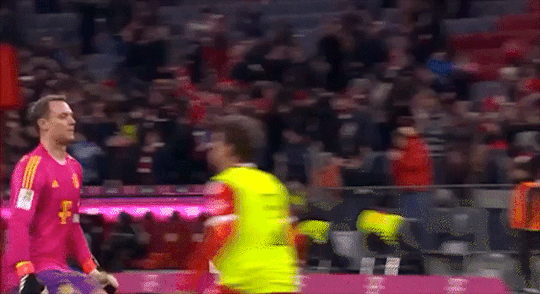

↳ 24.01: everyone’s favorite idiots in love seeing Raphaël Guerreiro’s goal and immediately doing the most sensible thing they could think of: leaping into each other’s arms and holding on for dear life

↳ 02.02: Manu waxing poetic about his special bond with his decade partner in an interview with Bild
↳ 03.02: Thomas reaches his milestone 500th win with Bayern and Manu makes damn sure the entire team celebrates it (including Thomas who’s trying to be all modest about it)
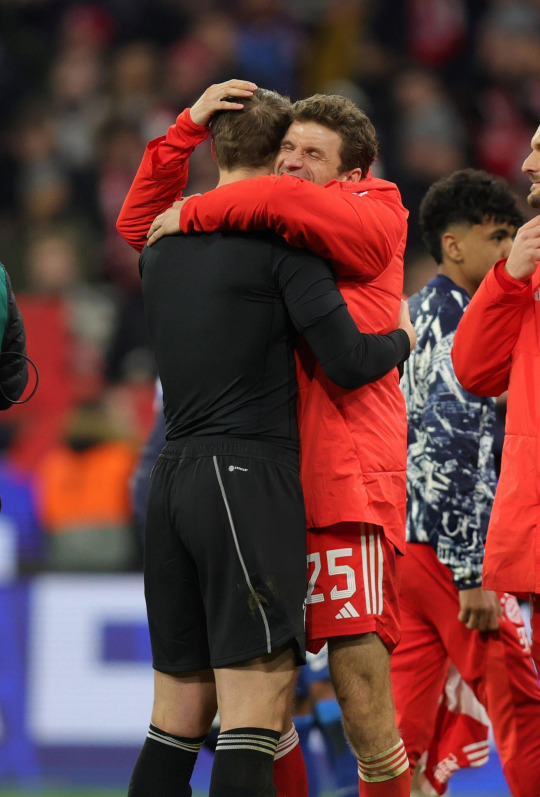
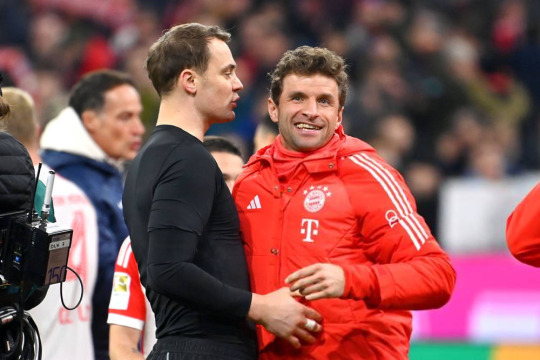
↳ 24.02: alllll the post-match snuggles after a win against Leipzig
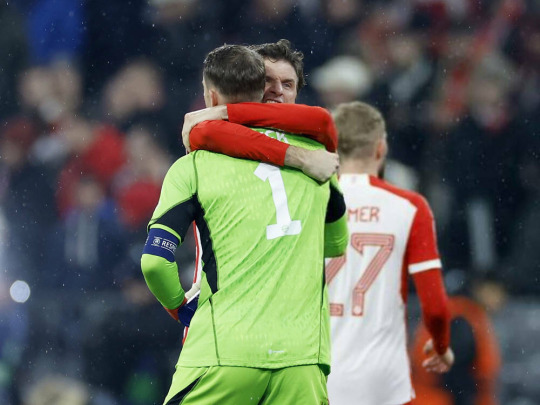
↳ 05.03: because no Bayern win is complete without a celebratory cuddle

↳ 18.05: Manu & Thomas hold hands after their match vs. TSG Hoffenheim
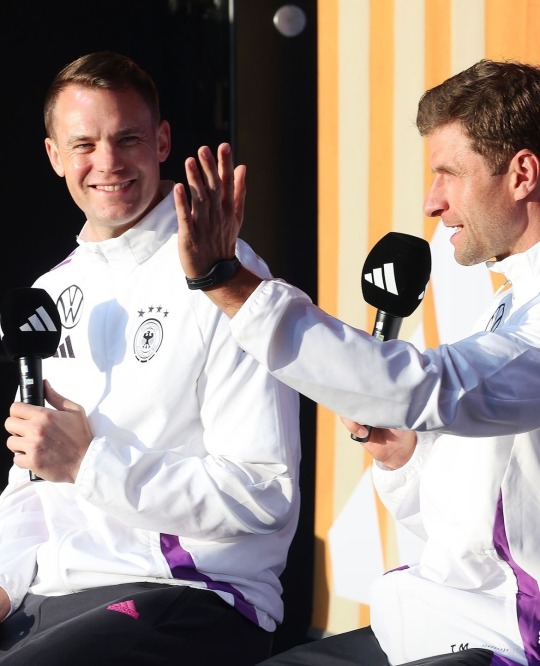
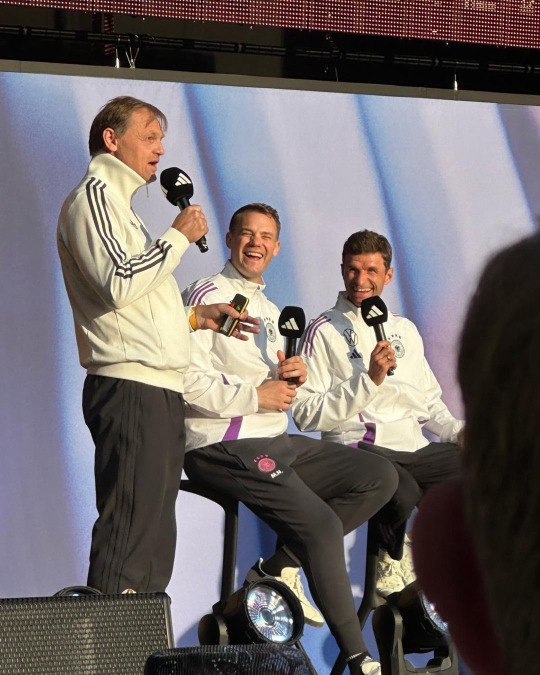
↳ 15.06: the decade partners attend the Adidas Three Stripes Festival together, as German law intended

↳ 17.06: Manu discusses his close relationship with Thomas during a Euros press conference


↳ 06.07: comforting each other after Germany is knocked out of their Heim-EM



↳ 15.07-21.08: Germany’s dads proving they’re the ultimate package deal by retiring from international duty within a month of each other
↳ 29.07: dare I say the reunion of the decade?!

↳ 29.08: gentle parenting tf out of Jamal
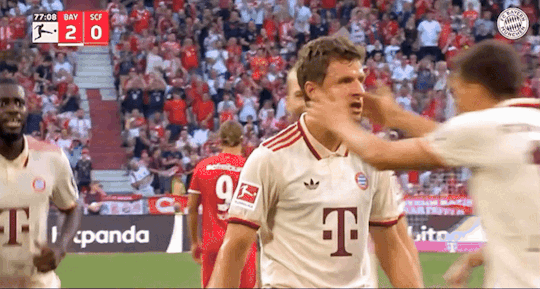




↳ 01.09: Thomas scores during his 710th competitive match for FC Bayern and Manu runs the length of the pitch to celebrate with him 🥰 complete with an almost-kiss because it wouldn’t be Neuller if there wasn’t one. And of course we can’t forget Manu’s post-match presser where all he did was talk about Thomas:

or how Thomas thanked him for celebrating the milestone with him



↳ 02.09: the ultimate neuller canon event: Thomas ✨confirms✨ he’s been married to Manu for 15 years and Manu pens a 4-paragraph love letter to him on the same day. But wait! There’s more! Manu also gives Thomas a “surprise” gift (and no, it’s not his questionable acting skills) to commemorate his 710th match for Bayern
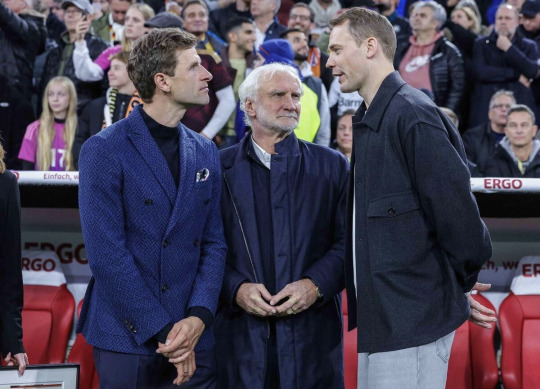
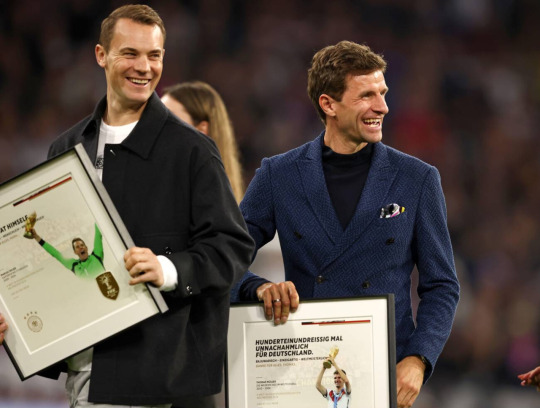
↳ 14.10: Manu and Thomas’ DFB sendoff Rudi Völler officiates the Neuller wedding vow renewal ceremony (those who get it GET it)

↳ 26.11: a little spooning after a match against PSG

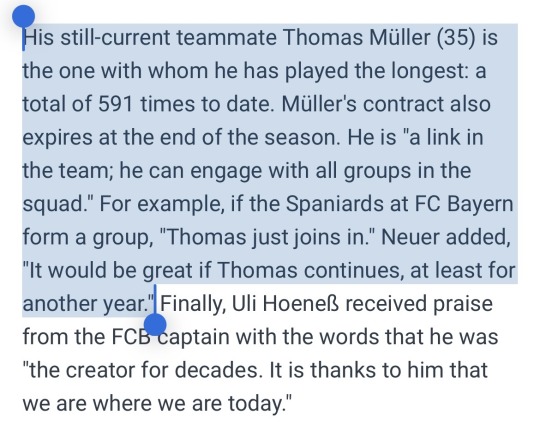
↳ 15.12: Manu discusses his hopes for a Thomas Müller contract extension during his annual fan club visit
#this took an embarrassingly long time to make omg#but also look at how many adorable moments our dads shared this year!#feel free to add onto this in any way you like (especially if I missed something significant) 😊#neuller#manuel neuer#thomas müller#thomas mueller#thomas muller#fc bayern#fc bayern munich#fc bayern münchen#germany nt#die mannschaft#dfb team#german nt#compilations#footballer quotes#honestly September 2 should be international Neuller day
95 notes
·
View notes
Text
Einstürzende Neubauten at Slurpen for “Tidskonsept II”, Oslo 1983.
Artist collective Lambretta invited Einstürzende Neubauten and Holy Toy to perform in their studio that they converted into a gallery space for the evening.
The locale was decorated with painted tv-screens, painted tarps, sheet metal and hanging oil drums, and playing documentary and propaganda clips from wartime Germany and the Soviet Union.
The performance was attended by the art elite, punks, and a tv-crew from the Norwegian national broadcasting network NRK.
The night ended with band members from Einstürzende Neubauten throwing Molotov-cocktails into the crowd, and the crowd reacting similarly by setting fire to the instruments and set design by Lambretta.
Videoclip taken from the NRK archives, Pan, episode “Musikk blir bilde”.
#einstürzende neubauten#einsturzende neubauten#neubauten#Lambretta#lakkergata skole#slurpen#Blixa Bargeld#f.m. einheit#mark chung#n.u. unruh#alexander hacke#industrial music#industrial#experimental#experimental music#music history#art history#this is like… my favorite artist collective in Norway… and I think it’s incredible they invited Neubauten#en#Blixa
396 notes
·
View notes
Text

Das leere Bild
The empty picture
0 notes
Text
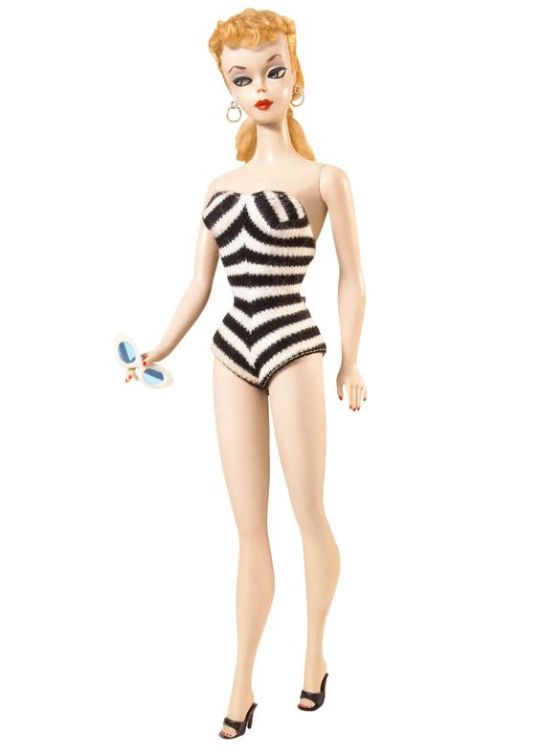
Barbie made her debut in 1959. The way she was sold then is a little different than the way she's sold now. These days, individual Barbies come with their own unique looks & usually some kind of unique function or accessories. You can buy clothes separately, but those looks are still secondary to the expectation of buying a lot of Barbies. Back in the day, you bought the one Barbie and then bought her clothes separately. This is why back then Barbie came with a bunch of friends and always came wearing a swimsuit.
The oft-memed origin story for the classic Barbie is that she was modeled on a German sex doll named Lili, which is only partially true. In the 50s, most dolls available for girls were baby dolls that primed girls for being a wife and mother. Fashion dolls were a thing but they were generally more reserved for adults.
Ruth Handler, who co-founded Mattel with her husband and served as its president from 1945-1973 (#girlboss much?), got the idea of making an adult doll for girls when she'd see her daughters playing with paper dolls. Instead of playing with babies, they chose teen-aged and adult paper dolls and played fantasized versions of adulthood. Then, on a trip to Germany, Ruth saw a Lili doll in a store, and asked her daughters what they'd think of playing with a doll like that. Apparently, they liked the idea.
Lili the doll wasn't an inflatable fuck doll. She was based on a popular comic strip character Lili created by Reinhard Beuthien and published in the Hamburg-based Bild Zeitung. Lili was a buxom gold-digger seducing her way through the wealthy men of post-war West Germany.
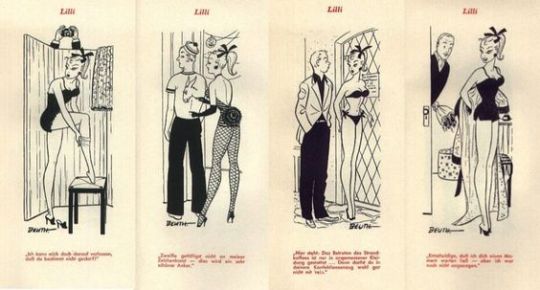
The comic was definitely adult-oriented, and the doll it created was a popular bachelor party gag gift.
The introduction of a doll with breasts did cause *some* controversy, but it was more pearl-clutching rather than tremendous cultural outrage. Barbie was actually an immediate hit. She fit in very well to late 50s ideals of femininity. I've heard it said before that parents liked her because she helped little girls get into the beauty, fashion, and level of grooming that she would need to catch a husband. IDK if that was intentional, but it seems to fit very well.
I don't want to get into whether or not Barbie is this huge feminist icon or not because, well, she's a toy. I think Ruth Handler was an incredibly smart businesswoman who saw a market demand and met it. Barbie is about the power of fantasy and imagination, and anything that people see in her are the things they want to see in her.
In her incredible multitude of careers, she also holds up an impossible and toxic standard of beauty. Mattel has always been very aware of Barbie's image. I'm pretty sure that the reason Mattel hated "Barbie Girl" so much wasn't because it was wink-wink sexual, but because it nailed the popular stereotype of the time that Barbie was this fake, plastic bimbo who was an unhealthy role model for girls (go listen to Aquarium, now!).
youtube
The recent years of Barbie taking on a more empowering, feminist, and diverse lean is because Mattel is simply correcting course and keeping up with the times. Honestly, they've done a very good job of it, but I'm not going to kid myself into thinking they're doing anything other than maximizing profits.
I love me some Barbie but I was always an AG girl, ngl. However, I think Barbie and her cultural context are still incredibly fascinating and worth taking a look at.
927 notes
·
View notes
Text
BERLIN — For the first time since the Nazi era, a far-right party in Germany has won the largest piece of the electoral pie in a state election.
Mainstream politicians and Jewish leaders are expressing alarm following Sunday’s elections, in which the anti-immigrant, Eurosceptic and pro-Russia Alternative for Germany party came out on top in the state of Thuringia, with 32.8% of the vote.
The 11-year-old party also earned second place to the traditional conservative Christian Democratic Union party in the neighboring state of Saxony. Both states are in the former East Germany.
“No one can brush this off as a ‘protest’ vote anymore,” Charlotte Knobloch, head of the Jewish community of Munich and Upper Bavaria, said in a statement late Sunday.
“Exactly 85 years after the start of World War II, Germany is in danger of becoming a different country again: more unstable, colder and poorer, less secure, less worth living in,” said Knobloch, a former head of the Central Council of Jews in Germany who herself survived the Holocaust in hiding.
The election came just over a week since a Syrian refugee was arrested after a deadly stabbing spree at a festival in the city of Solingen, and only days after Germany resumed its program of deporting refugees convicted of crimes. The knife attack, in which three people were killed, reignited popular anxiety about social unrest connected with the more than 1 million refugees admitted to Germany since 2015.
AfD stresses isolationism, takes an anti-EU and pro-Russian stance, and is accused of fomenting anti-Muslim sentiment. Some of its most extreme representatives have also belittled the Holocaust, saying that Germany has paid enough penance for the sins of an older generation.
Mass protests against the party took place earlier this year following revelations that the party had held a secret meeting at a lakeside villa to discuss plans to deport foreigners, including those who had become German citizens. Prominent neo-Nazis attended the meeting, according to the news organization that broke the story, inducing painful echoes of the gathering of Nazi leaders at nearby Wannsee in 1942 to devise a plan to deport and then murder Jews.
But while support for the AfD dipped in polls at the time, it soon rebounded and then accelerated. Now, it has achieved breakthrough results in state elections and raised concerns for next year’s national elections.
The party — whose Thuringen leader, Bjoern Hoecke, has been convicted twice of using a Nazi slogan to boost his party — is unlikely to form a ruling coalition in either state, since it is shunned by other parties. Still, it will have additional seats in the state legislatures and will have the numbers, particularly in Thuringia, to interfere with some governing decisions.
A far-left party, Sahra Wagenknecht Alliance or BSW, also produced notable results, coming in third in Thuringia with 15.8% of the vote. Last month, the current head of the Central Council of Jews in Germany, Josef Schuster, warned that the party, which has accused Israel of genocide in its war in Gaza, was “fueling hatred of Israel in Germany.”
The new election results bode ill for Germany’s future, Schuster said on Sunday.
“Can we recover from this hit?” Schuster wrote in a column in the Bild newspaper. “Our free society must not fall, especially in the face of Islamist terror. Unvarnished truths — honesty and sincerity — are needed, not populist pseudo-answers from radical parties.”
In Thuringia, the mainstream Social Democratic Party barely squeaked in, with 6.1%. Several parties, including the Greens and Free Democratic Party, received so few votes that they will not have any seats at all.
BSW also came in third in Saxony, with 11.8% of the vote, following the AfD with 30.6% and the CDU with a narrow win at 31.9%.
Younger voters overwhelmingly favored the AfD in this week’s elections, according to an NTV-Infratest exit poll.
“The survivors are asking themselves: ‘Didn’t we do enough to teach, to tell, to show?” Christoph Heubner of the International Auschwitz Committee, told the Guardian.
Some Jewish leaders say German politicians would do well to address the concerns apparently expressed by voters this weekend.
“The election results in the German federal states of Thuringia and Saxony are a clear wake-up call to the centrist parties in Germany to listen to the real concerns and fears of the people,” Rabbi Pinchas Goldschmidt, president of the Conference of European Rabbis, said in a statement. “When half the population votes for parties on the extreme fringes, their problems must be addressed openly and honestly.”
Sunday was an “insanely sad” election day, German Jewish journalist Samira Lazarovic wrote on Facebook. She said her 96-year-old father compared the outcome to the opening salvo of World War II, exactly 85 years ago.
Lazarovic said it was is urgent to reach out to younger voters. “It’s not that we know better than they; but we should shape the future together.”
Obviously, it wasn’t enough to take to the streets and protest against the far right, she added: “Populists all over the world have one thing in common. They mean exactly what they say and do everything they can to turn their words to deeds.”
81 notes
·
View notes
Text

HIM backstage at Magdeburg, Germany (2000) [Photo by snapshot-photography/ullstein bild via Getty Images]
20 notes
·
View notes
Text
It's been a while since I've wanted to write about a German celebrity couple who have a really private relationship. His name is Mark Forster and he is a very famous singer around here. Her name is Lena, and she is a German singer who became known after representing Germany in the Eurovision Song Contest in 2010 (winning). If you read or watch their interviews or look at their social networks, you will get the feeling that they are two single people with nothing in common. There is no indication on Lena's Instagram that she was pregnant and gave birth to a child. There is no indication on Mark's Instagram that he is a father. There are many sightings, but no compromising photos of the two lovebirds, even though they are pursued by gossip-hunting newspapers. This is what the press writes about them:
"Lena and Mark have known each other for years and have been on the jury of "The Voice Kids" together since 2016. They also appeared together in front of the camera on "Sing meinen Song - Das Tauschkonzert". The two were in long-term relationships at first, but their flirtation had turned into a relationship, reports "Bild".
Since then, MarLena - that's their couple name - have tried to keep their love a secret. During filming, they are said to have spent "a conspicuous amount of time" together, but officially always presented themselves as "best friends," the newspaper continues. "After filming, they also had themselves transported out of the studio in separate cars."
It had long been a topic of conversation that they were more than just friends. Guests had also observed them leaving a hotel restaurant holding hands - but then walking separately down the sidewalk. No pictures.
"He keeps her grounded"
"Mark kept raving about the little gifts that Lena brought him," an insider is quoted as saying. Another said: "Mark keeps her grounded and he is a grown-up person, which was no longer the case in their other relationship."
There has not been a statement from the musician couple yet. The two are not yet Insta-official either: Lena posted photos from their vacation together - but without Mark. "
The photos of the two circulating in the web are from professional events in the projects they did together, but nothing like the vibe of a parade of co-workers in love.
These two are a great example that any celebrity who wants to keep a relationship private can do so. And they can do it with class, elegance and without having to lie. I know they are different contexts, but I think that with good professional advice you can make things work correctly, without having to resort to so many disastrous tricks.

#outlander#shipping#sam heughan#shipper#fandom is for fun#thehardlifeofshippers#welcome to the shitshow#samcait
58 notes
·
View notes
Note
Hi!
Fitness Anon here…
The brand new photos of S’s pap walk in Soho today remind me of something I wanted to share with you about AM (now AD): Her husband plays football in Germany. About ten day ago there were reports in the yellow press about the get together of thee Munich players and their families as the Bundesliga sesason had ended.
AM was mentioned there with her baby. It was stated that she had previous relationships with other sport stars. None of these news mentioned her being linked to S.
https://www.bild.de/sport/fussball/fc-bayern-kennen-sie-die-alle-schon-das-sind-bayerns-neue-spielerfrauen-664c48952c12487f81715baf
Dear (returning) Fitness Anon,
I will translate the relevant part of that article. It's funny how S didn't make the Bild editor's cut, eh?
He should really stop wasting money on such #silly BS. Nobody - I repeat: NO-EFFIN'- BODY - gives a flying fuck anymore.
Ok, perhaps Data Lounge does give a (static) fuck, but this is what they do for just about everybody in showbiz. S's personal brand has seemingly gone from magic to trash. Let us hope it won't turn into a cautionary tale of sorts.
But onwards to Bild's article: 'Do you know all of them? These are the wives of the new players of the Bayern Munich'
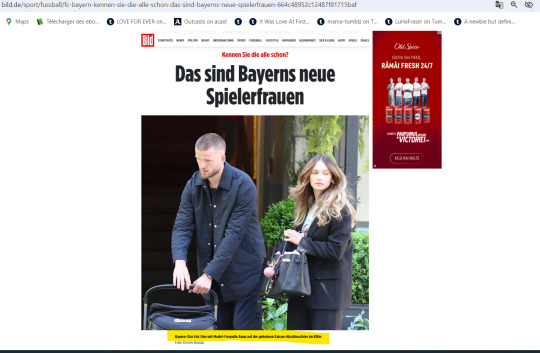
[Photo legend: 'the Bayern star player Eric Dier with his model girlfriend Anna at the secret end-of-season party at the Käfer']

'Are you familiar with all these ladies?
Last Sunday [note: May 19th], FC Bayern organized a secret end-of-season party at Munich's upscale Käfer restaurant - despite the 2:4 defeat in Hoffenheim, the drop to third place in the Bundesliga and the first season without a title since 2012, the mood among the majority of guests was good.
It was a true family brunch! Featuring some lesser known faces... (....)'
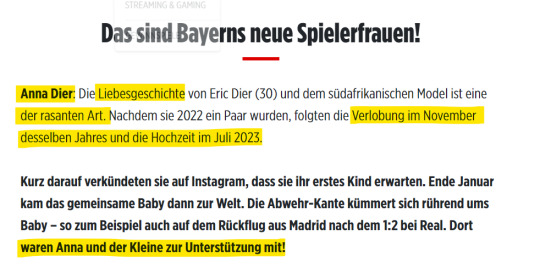

Anna Dier: It was love at first sight for Eric Dier (30) and the South African model. After they became a couple in 2022, they got engaged in November of the same year and married in July 2023.
Shortly after, they announced on Instagram that they were expecting their first child. The baby was born at the end of January [2024]. The defender player shows loving care for the baby, as seen on the return flight from Madrid, after the 1-2 defeat in the match opposing the Real. Anna and the little one went there to support him!
Before meeting Eric Dier, Anna was in a relationship with Alexis Sanchez (35). The Chilean record international player formerly was active at Arsenal FC, Manchester United, Inter Milan and Olympique Marseille, among others.'
But... but...
Vielen Dank, dear Fitness Anon. Between three Tumblr trolls and Das Bild, I choose to believe Germany's best-selling daily newspaper, that's been around since 1952.

47 notes
·
View notes